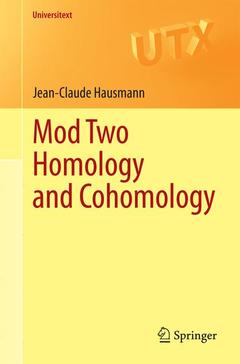Description
Mod Two Homology and Cohomology, 2014
Universitext Series
Author: Hausmann Jean-Claude
Language: English
Keywords
535 p. · 15.5x23.5 cm · Paperback
Description
/li>Contents
/li>Biography
/li>Comment
/li>
Cohomology and homology modulo 2 helps the reader grasp more readily the basics of a major tool in algebraic topology. Compared to a more general approach to (co)homology this refreshing approach has many pedagogical advantages:
1. It leads more quickly to the essentials of the subject,
2. An absence of signs and orientation considerations simplifies the theory,
3. Computations and advanced applications can be presented at an earlier stage,
4. Simple geometrical interpretations of (co)chains.
Mod 2 (co)homology was developed in the first quarter of the twentieth century as an alternative to integral homology, before both became particular cases of (co)homology with arbitrary coefficients.
The first chapters of this book may serve as a basis for a graduate-level introductory course to (co)homology. Simplicial and singular mod 2 (co)homology are introduced, with their products and Steenrod squares, as well as equivariant cohomology. Classical applications include Brouwer's fixed point theorem, Poincaré duality, Borsuk-Ulam theorem, Hopf invariant, Smith theory, Kervaire invariant, etc. The cohomology of flag manifolds is treated in detail (without spectral sequences), including the relationship between Stiefel-Whitney classes and Schubert calculus. More recent developments are also covered, including topological complexity, face spaces, equivariant Morse theory, conjugation spaces, polygon spaces, amongst others. Each chapter ends with exercises, with some hints and answers at the end of the book.
Jean-Claude Hausmann is honorary professor of Mathematics at the University of Geneva. His domains of interest include topology of high-dimensional manifolds, with applications to configuration spaces inspired by topological robotics and Hamiltonian geometry.
Presents a simplified version of these important tools of algebraic topology
Provides a self-contained introduction to mod 2 (co)homology
Begins with basic principles and leads up to advanced topics that are not usually mentioned in an algebraic topology text
Includes many interesting applications of mod 2 homology and cohomology theory, both classical and more recent
Includes supplementary material: sn.pub/extras
These books may interest you

Basic Algebraic Topology 123.78 €

Singular Intersection Homology 168.43 €


